-
PDF
- Split View
-
Views
-
Cite
Cite
Nobuyoshi Kawaharada, Kiyofumi Morishita, Johji Fukada, Yoshikazu Hachiro, Yasuaki Fujisawa, Tatsuya Saito, Yoshihiko Kurimoto, Tomio Abe, Stroke in surgery of the arteriosclerotic descending thoracic aortic aneurysms: influence of cross-clamping technique of the aorta, European Journal of Cardio-Thoracic Surgery, Volume 27, Issue 4, April 2005, Pages 622–625, https://doi.org/10.1016/j.ejcts.2004.11.028
Close - Share Icon Share
Abstract
Objective: The risk of stroke caused by dislodgment of loose atheromatous plaque or mural emboli is increased by cross-clamping of the aorta. Some patients undergo descending thoracic aortic aneurysm repair with proximal aortic cross-clamping between the left common carotid artery and the left subclavian artery. The objective of this study was to determine the influence of proximal aortic cross-clamping in arteriosclerotic aneurysm or dissecting aneurysm repair. Methods: Between May 1984 and May 2003, 81 patients underwent elective surgery for distal arch or descending aortic aneurysm repair with proximal aortic cross-clamping between the left common carotid artery and the left subclavian artery. To evaluate the influence of the proximal aortic cross-clamping, patients were divided into two groups: patients who had undergone arteriosclerotic aneurysm repair (group I, n=25) and patients who had undergone dissecting aneurysm repair (group II, n=56). Results: Eight (9.9%) of the 81 patients had a stroke. Six strokes occurred in operations for arteriosclerotic aneurysm repair group I and two strokes occurred in operations for dissecting aneurysm repair group II (24 vs 3.6%; p=0.009). In-hospital mortality rates were 12% in group I and 8.9% in group II (p=0.70). Major postoperative complications included renal failure requiring hemodialysis (in 4.2% of the patients in group I and in 8.3% of the patients in group II, p=0.99) and pulmonary complication (in 20% of the patients in group I and in 16% of the patients in group II, p=0.67). Conclusion: Cross-clamping between head vessels should be avoided if at all possible when operating on patients who have arteriosclerotic descending thoracic aneurysms.
1 Introduction
Stroke is a devastating complication of surgery of the thoracic aorta and occurs as frequently in descending aortic operations as in ascending aortic operations. According to previous reviews, the incidence of stroke after surgery is 2.0–11.0% for operations on the ascending aorta or arch aorta and 2.0–8.1% for operations on the descending aorta or thoracoabdominal aorta[1–6]. Aneurysms that arise in the distal aortic arch and subclavian artery frequently involve large segments of the descending thoracic aorta and are easily approached through a left thoracotomy. Surgical treatment of aneurysms of the distal arch or descending thoracic aorta usually involves cross-clamping of the aorta. Kay and colleagues reported that distal arch aneurysms could be repaired without subsequent occurrence of stroke by the use of a simple cross-clamp placed between the innominate and left carotid arteries through a posterolateral thoracotomy [7].
However, we believe that manipulation of the aortic arch for proximal control in descending aortic operations and cross-clamping between vessels branching from the aortic arch are factors causing stroke in descending aortic operations. Unfortunately, there are no reviews in which the incidence of stroke in arteriosclerotic aneurysm operations and that in dissecting aneurysm operation are compared.
2 Materials and methods
2.1 Patients
During the period from March 1984 to May 2003, 81 patients underwent elective surgery for distal aortic arch or descending aortic aneurysm repair with proximal aortic cross-clamping between the left common carotid artery and the left subclavian artery. Data from the hospital records of those patients were obtained from our departmental registry. Twenty-four patients with arteriosclerotic aneurysms (group I) and fifty-seven patients with dissecting aneurysms (group II) underwent graft anastomosis with the use of distal perfusion and the proximal aortic cross-clamp had to be placed between the left common carotid artery and the left subclavian artery because the aneurysm involved the aorta at the origin of the left subclavian artery. The 24 patients in group I included 22 men (92%) and 2 women (8%), and the patients’ ages ranged from 35 to 78 years (median, 66 years) and the 57 patients in group II included 45 men (79%) and 12 women (21%) and the patients’ ages ranged from 28 to 75 years (median, 55 years) (Table 1). In all of the patients, preoperative diagnosis excluded the possibility of an operation with cross-clamping of the aorta.
2.2 Surgical procedure
All of the patients were positioned in right lateral decubitus. A double-lumen endotracheal tube was placed in each patient. A proximal incision was made in the third or fourth intercostal space. If the aneurysm was extensive, an additional intercostal incision was made in the sixth or seventh space to facilitate distal dissection near the diaphragm. This double thoracotomy was accomplished through a single incision in the skin and chest wall.
In both groups of patients, repair was performed with proximal cross-clamping of the aorta, the clamp being placed between the left common carotid artery and left subclavian artery with partial cardiopulmonary bypass without hypothermia, and arterial and venous cannulation was performed through the right femoral vessels. After proximal cross-clamping, distal perfusion was started by partial cardiopulmonary bypass. After completion of the proximal anastomosis, the tube graft was clamped and the proximal aortic clamp was released. The distal anastomosis was then completed in the usual manner.
2.3 Statistical analysis
Data were processed using Stat View J-5.0 software (Abacus Concepts Inc, Berkeley, Calif). Variables in groups I and II were compared using the χ2 test, Fisher's exact test, Student's t-test and Mann–Whitney U-test. Data for times and age are presented as means±SD.
3 Results
Table 1 summarizes the characteristics of the patients. The mean age of patients in group II, including patients with Marfan syndrome, was significantly lower than that of patients in group I. Distal aortic perfusion time and clamp time in group II were significantly longer than those in group I (Table 2). This is thought to be because of the time needed to reconstruct the two lumina, close the false lumen and reestablish and maintain satisfactory flow through the true lumen (Table 2).
Eight (9.9%) of the 81 operations resulted in cerebrovascular accidents, defined as permanent, new, central neurologic deficits. Spinal cord ischemia was not included in the analysis. Six strokes occurred in operations for arteriosclerotic aneurysm repair in group I, and 2 strokes occurred in operations for dissecting aneurysm repair in group II (24 vs 3.6%; p=0.009)(Table 3). Six (75%)of the 8 strokes in the two groups were left side infarctions(Table 4). Six patients (7.4%) were returned to the operation room due to postoperative bleeding. Postoperatively, 14 patients (17%) had pulmonary complications, 3 patients (3.7%) had gastrointestinal complications, and 3 patients (3.7%) had renal failure, which required temporary or chronic hemodialysis. There were no statistically significant differences in the rates of these complications or rates of renal failure between groups I and II. Rates of mortality, stroke, renal failure (hemodialysis), pulmonary complication, postoperative bleeding, wound complication and gastrointestinal complications are summarized in Table 3.
The overall 30-day and in-hospital mortality rates for the 81 patients who underwent thoracic aortic aneurysm repair were 7.4% (6 patients) and 9.9% (8 patients), for groups I and II, respectively. There was no significance difference between in-hospital mortality rates in the two groups. There was also no difference in the causes of in-hospital mortality (Table 5).
4 Discussion
Prevention of cerebral embolic events is one of several important clinical considerations during surgery of the thoracic aorta. Because the descending aorta, being downstream from the head vessels, is not thought to be a major source of air or particulate matter, occurrence of stroke is somewhat counterintuitive in operations on the descending aorta. Surgical treatment of aneurysms of the descending thoracic aorta usually involve cross-clamping of the aorta. This study showed that stroke does indeed occur in descending aortic operations, and it is thought that manipulation of the aortic arch for proximal control in descending aortic operations and cross-clamping between the head vessels increase the risk of stroke caused by dislodgment of loose atheromatous plaque or mural emboli [8,9].
We had to focus on antiembolic precautions because intraoperative emboli are the major source of cerebrovascular accidents. We do not think that femoral perfusion is pertinent as a cause of cerebral infarction in descending aorta operation with cross-clamping; the reason being that a partial cardiopulmonary bypass is usually used to decompress the heart and cross-clamping of the aorta is done with care after blood pressure has decreased slightly to prevent the occurrence of disruption of any atheromatous debris. After aortic cross-clamping is done, distal perfusion from the femoral artery is initiated, and with this method there is no flow to the cerebral vessels.
Although it is true that our study is made up of patients, over a long period of time and that the number of patients with arterosclerotic aneurysms was rather small, stroke was nonetheless found to occur frequently after arteriosclerotic descending aortic surgery (in 24% of operations on arteriosclerotic descending aortic aneurysms and in 3.6% of operation on dissecting descending aortic aneurysms; p=0.009). And it is presumed that emboli actually flowed into the left common carotid artery as a result of manipulation or cross-clamping between the head vessels in 6 of the 8 cerebral infarction cases, because in 6 patients (75%) the strokes were left side cerebral infarctions. Even simple mobilization for an operation on a severely diseased descending aorta can liberate debris to the cerebral vessels. Care must therefore, be taken in manipulation of the aortic arch for proximal control in descending aortic operations [10,11].
Consequently, contrary to conventional practice of cross-clamping the proximal arteriosclerotic aorta between the head vessels, we do not recommend this course of action. However, these difficulties mainly exist in cases of aneurysms located in the proximal descending thoracic aorta very close to the aortic arch. In such cases, deep hypothermic circulatory arrest with open proximal anastomosis may be useful [12,13]. Although cannulation of the femoral artery is used routinely with deep hypothermic circulatory arrest for thoracic aortic operations without cross-clamping of the aorta, retrograde perfusion through the descending aorta carries the risk of cerebral malperfusion or embolism. We believe that retrograde perfusion from the femoral artery to perform deep hypothermic circulatory arrest is a factor responsible for stroke in descending aortic operations without cross-clamping of the aorta. We have therefore, recently been using ascending aortic cannulation or right axillary artery perfusion with graft to achieve proximal aortic perfusion with passive cerebral flow for distal arch and descending aortic operations through a left thoracotomy [14,15].
We conclude that the possibility of dislodging loose atheromatous plaque or occurrence of mural emboli in arteriosclerotic descending thoracic aneurysms is increased by proximal cross-clamping and that, therefore, open proximal anastomosis in deep hypothermic circulatory arrest should be considered when operating on patients who have arteriosclerotic aneurysms for which cross-clamping between the head vessels is necessary.
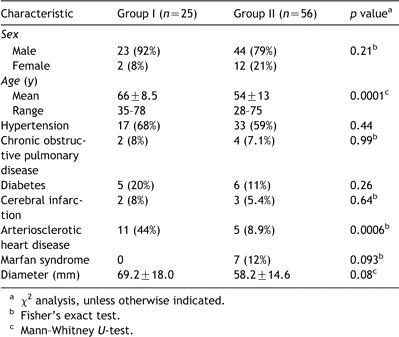
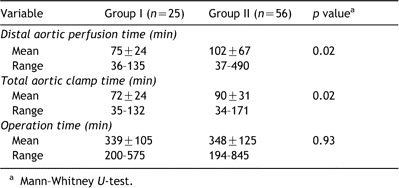
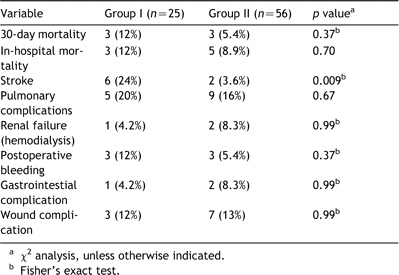
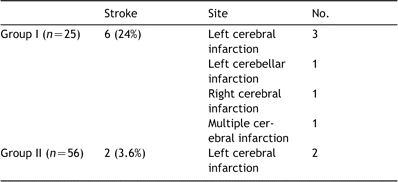
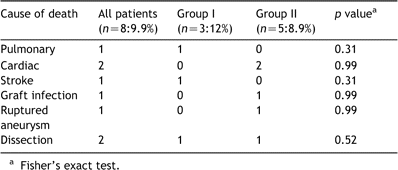
Presented at the joint 18th Annual Meeting of the European Association Cardio-thoracic Surgery and the 12th Annual Meeting of the European Society of Thoracic Surgeons, Leipzig, Germany, September 12–15, 2004.
References
- aorta
- atheroma
- aortic aneurysm, thoracic
- hemodialysis
- cerebrovascular accident
- aneurysm
- postoperative complications
- repair of aneurysm
- kidney failure
- aneurysm, dissecting
- common carotid artery
- hospital mortality
- surgical procedures, elective
- surgical procedures, operative
- embolism
- stroke risk
- pulmonary complications
- descending thoracic aortic aneurysm
- aortic cross clamping
- thoracic descending aortic aneurysm repair
- left subclavian artery




